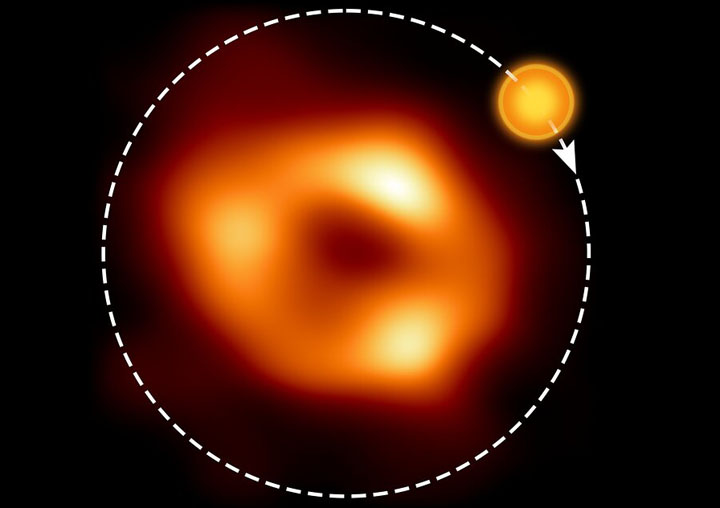Orbital motion detected near black hole event horizon
- Press Office
- September 22nd, 2022

An international team, with the participation of the Universitat de València, has identified the signal of a bubble of hot gas orbiting in the vicinity of Sagittarius A* (the supermassive black hole at the centre of our galaxy). The observation was made with the ALMA telescope (Atacama large mm/submm Array). The bubble orbited only a few light-minutes from the black hole, which may help to better understand how matter behaves in these enigmatic regions so close to the event horizon.
“We were lucky that ALMA started observing Sagittarius A* just after an X-ray burst, caused by the heating of a gas bubble very close to the black hole,” said Iván Martí Vidal, from the Department of Astronomy and Astrophysics at the Universitat de València. “After calibrating the data with novel algorithms developed at the UV, we realised that we had detected an enigmatic signal related to that X-ray burst. It was an extraordinary experience,” said the researcher.
“We think we are seeing a bubble of very hot gas orbiting Sagittarius A* at a distance similar to that separating Mercury from the Sun, but with a period of only about 70 minutes. This implies that the speed of this bubble must have reached brutal values, on the order of 30% of the speed of light,” said Maciek Wielgus, from the Max-Planck Institute for Radio Astronomy (MPIfR) in Bonn, Germany, and first author of the paper published today in the journal 'Astronomy & Astrophysics'.
The ALMA telescope, located in the Chilean Andes and involving the European Southern Observatory (ESO), was part of the 2017 Event Horizon Telescope (EHT) observing campaign. Combining ALMA with the rest of the EHT, the collaboration obtained the first image of Sagittarius A*, which was recently published. To the researchers’ surprise, the ALMA data (on its own, without combining it with the EHT) also held interesting clues about the nature of the black hole.
X-ray bursts (such as the one detected by NASA's Chandra satellite on the same day it observed the EHT) are thought to be related to the creation of very hot bubbles of gas (called 'hot spots'), embedded in the material surrounding the black hole.
“What is really interesting is that such bursts have only been detected in X-rays and in the infrared. This is the first time we have seen a clear signal linking the radio emission (i.e. what ALMA observes) to hot spots orbiting the black hole,” said Wielgus, who is also affiliated with the Nicolaus Copernicus Astronomical Centre (Poland) and the Black Hole Initiative at Harvard (USA).
“It is possible that these hot spots that also shine in the infrared are the ones that, after cooling down, also emit at lower frequencies, to which ALMA is sensitive,” added Jesse Vos, a PhD student at Radboud University in the Netherlands and co-author of the paper.
It had long been believed that the X-ray flares were produced by magnetic interactions of very hot gas orbiting Sagittarius A*. The new results corroborate this idea. “We have just found strong evidence that this outburst had a magnetic origin and, in fact, our observations even give us information on the geometry (the spatio-temporal metric) in which this process occurred,” explains Monika Moscibrodzka, from Radboud University and co-author of the paper.
ALMA allows us to study the polarised emission from Sagittarius A* with unprecedented sensitivity, making it possible to study the magnetic nature of this X-ray outburst. The research team used these observations, combined with theoretical models of General Relativity, to unravel the formation and evolution of this gas bubble and its surroundings. This link shows an animation of the actual ALMA observations: https://youtu.be/MuaBMCOfvYk
The observations confirm some of the previous discoveries made by [GRAVITY], ESO's instrument on the Very Large Telescope (VLT), which observes in the infrared. According to ALMA data, combined with GRAVITY, these outbursts are related to clusters of gas orbiting at 30% of the speed of light, in a clockwise direction and with a very small inclination with respect to the Earth's visual.
“In the future, we should be able to combine different instruments, such as the EHT, GRAVITY and ALMA, to observe these phenomena at different frequencies; achieving this would mark a turning point in our understanding of the physics behind these enigmatic energy bursts in the Galactic Centre,” concludes Iván Martí Vidal.
File in: Internacionalització recerca
















